What Is a Social Media Competitor Analysis?
A social media competitor analysis involves collecting and evaluating information about your competitors’ social media presences. Which helps you understand their strengths and weaknesses and reveals ways you can improve your own social media strategy.
Running a competitive analysis for social media enables you to:
- Benchmark your performance
- Identify areas of opportunity and differentiation
- Get to know your target audience on a deeper level
- Discover new trends or conversations you can cover
We recommend running a social media competitive analysis once a quarter to ensure you stay up to date with competitor and industry changes.
How to Do a Social Media Competitor Analysis
Follow along for how to do a competitor social media analysis in six steps:
1. Identify Your Competition
Build a list of your main competitors to inform your analysis.
While you could focus on both direct competitors and indirect competitors (those that sell different products or services but may compete with you for market share), focus on your direct competitors.
Why?
Because direct competitors are businesses most similar to your own. So you can get the most accurate information.
Use Semrush’s Market Explorer to identify your main competitors and get insights into the competitive landscape.
Here’s how:
First, select “Find Competitors” and enter your domain.
Then, click “Research a market.”

The “Overview” tab shows who you compete with online. And provides information about market share, audience size, and more.
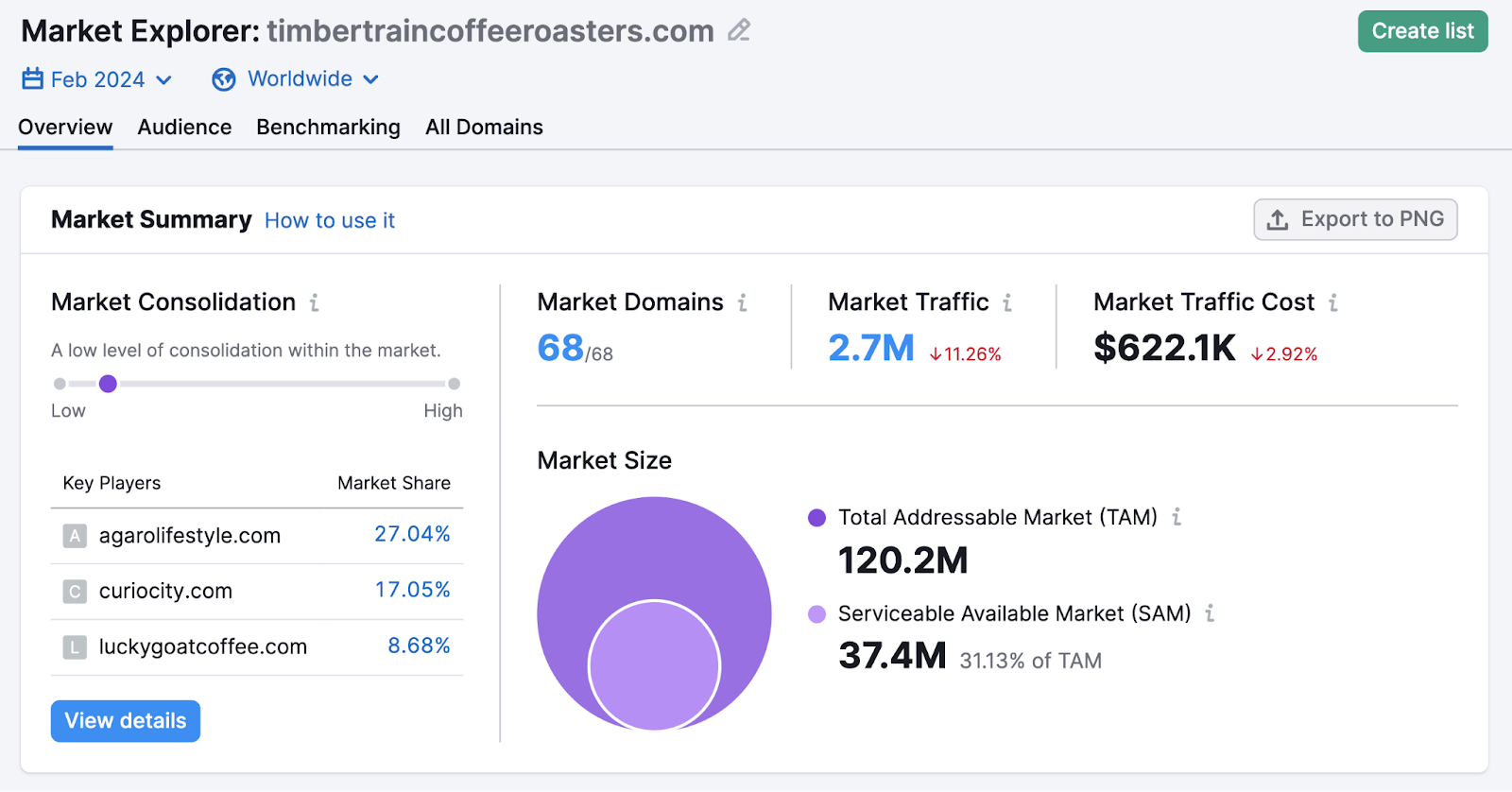
Next, scroll down to the “Growth Quadrant” widget. This breaks down you and your competitors into four basic categories:
- Game Changers: Emerging businesses with high growth potential
- Leaders: Businesses with both large audiences and high growth rates
- Niche Players: Businesses with small audiences and low growth rates
- Established Players: Established businesses with large audiences
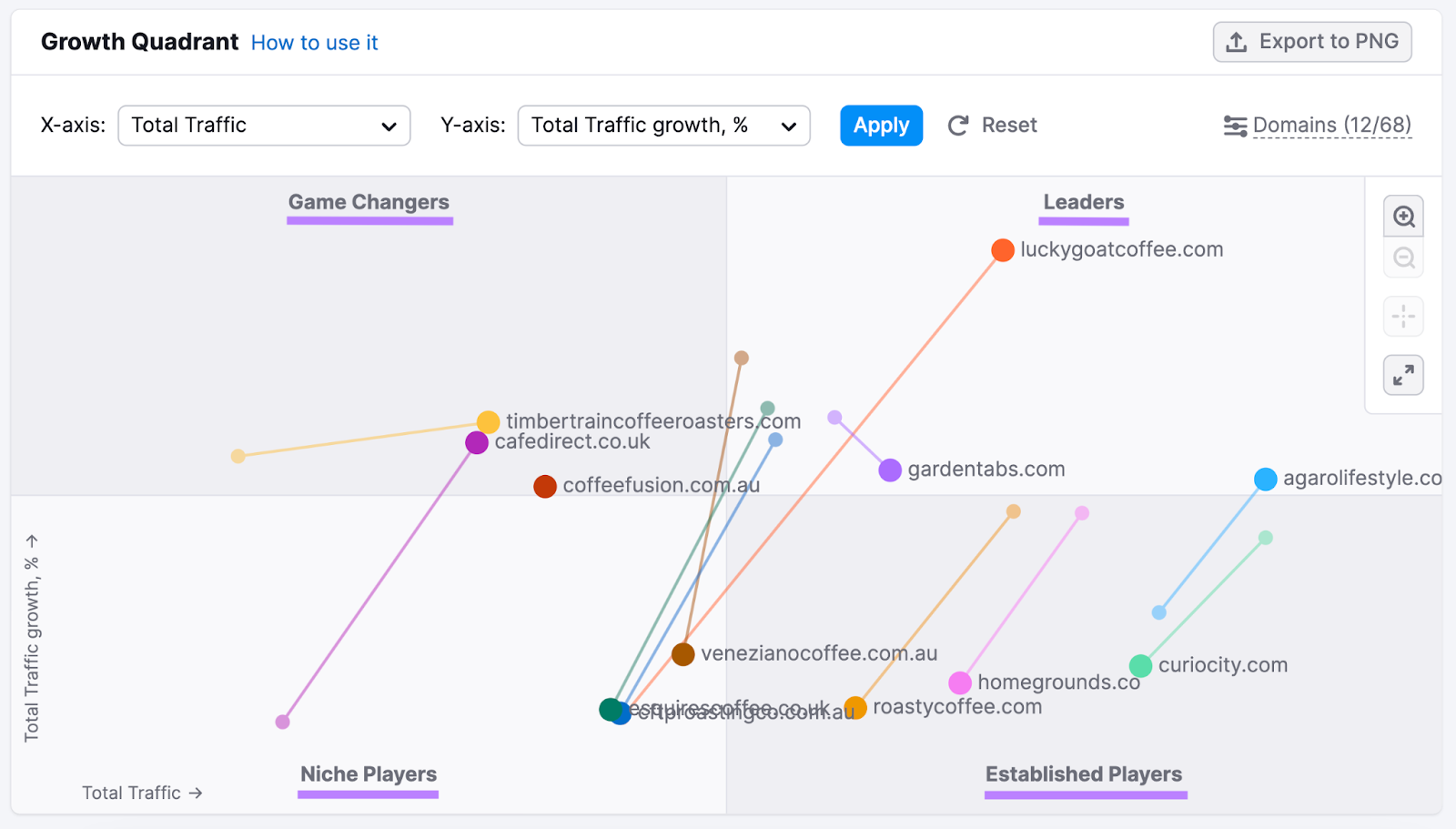
Note where each competitor stands and how their audience and traffic growth compare to yours. Then, create a list of your top five competitors.
2. Analyze Audiences and Platforms
Getting to know your competitors' target audiences can reveal relevant segments you aren’t yet targeting. Which can inform changes you may need to make to reach and engage similar audiences.
To do this, you’ll want to compare characteristics like:
- Demographics: Age, gender, location, etc.
- Socioeconomics: Education level, income, household size, etc.
- Psychographics: Interests, values, goals, etc.
- Behaviors: Habits, preferences, pain points, etc.
Use One2Target to look at your competition’s audiences.
Open the tool, enter at least one competitor’s domain, and click “Analyze.”
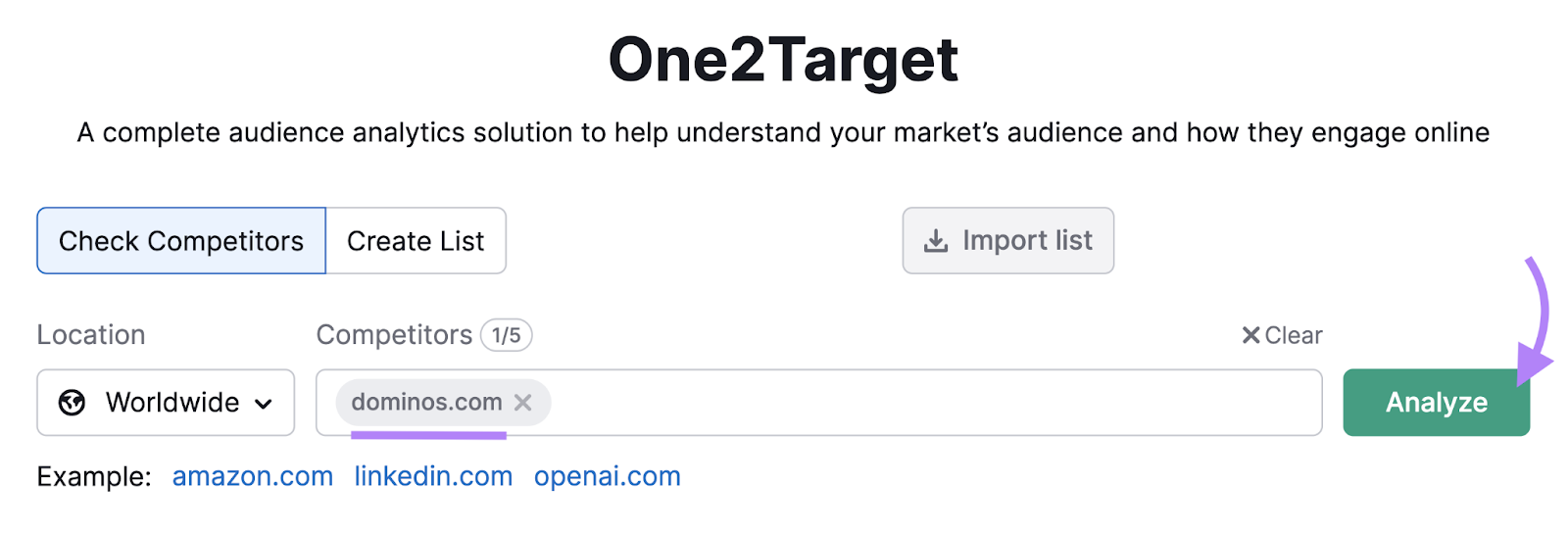
The “Demographics” tab shows a breakdown of their audience by age, gender, and location.
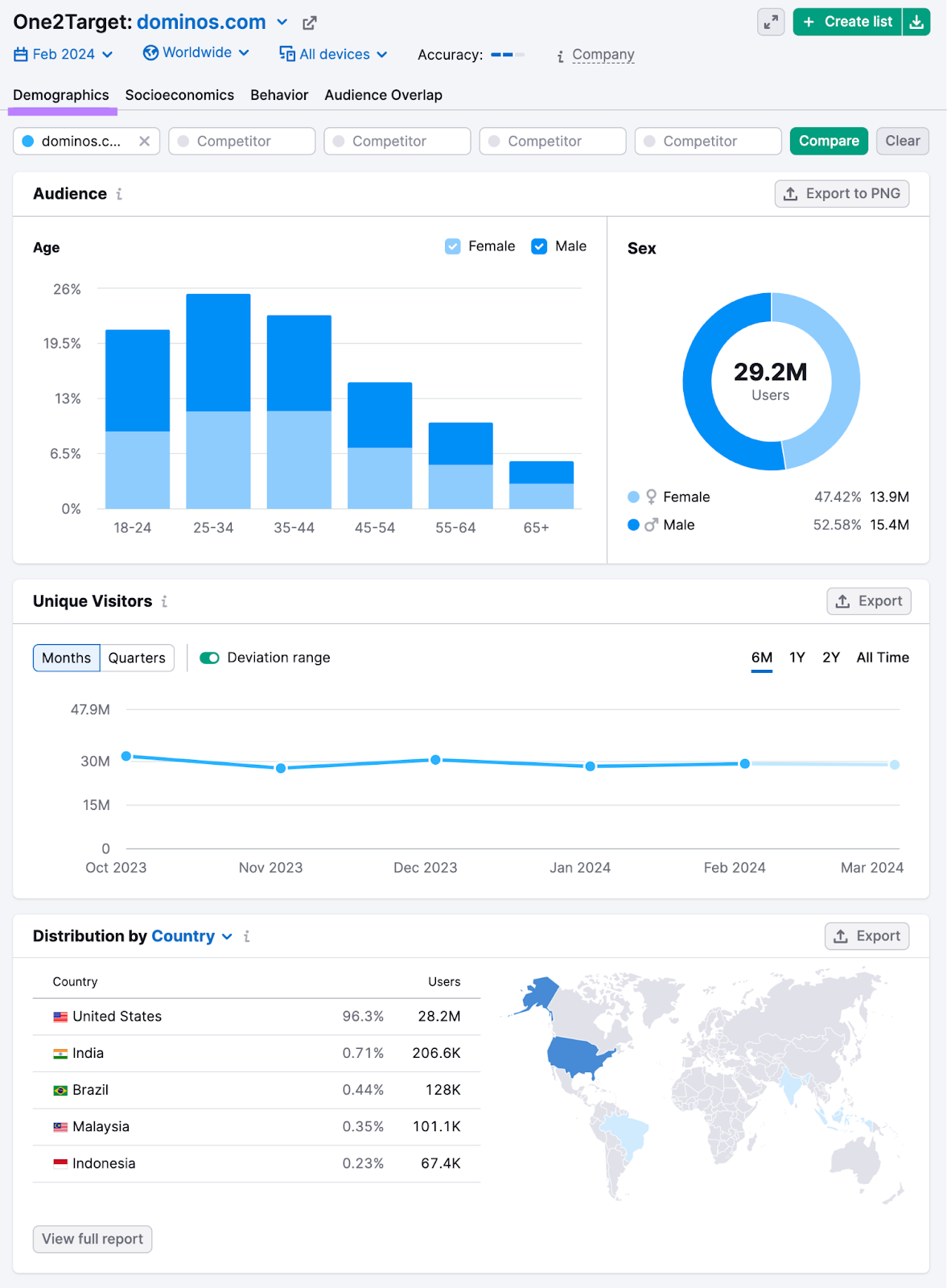
Click the “Socioeconomics” tab to view data about the audience’s household size, household income, education level, and employment status.
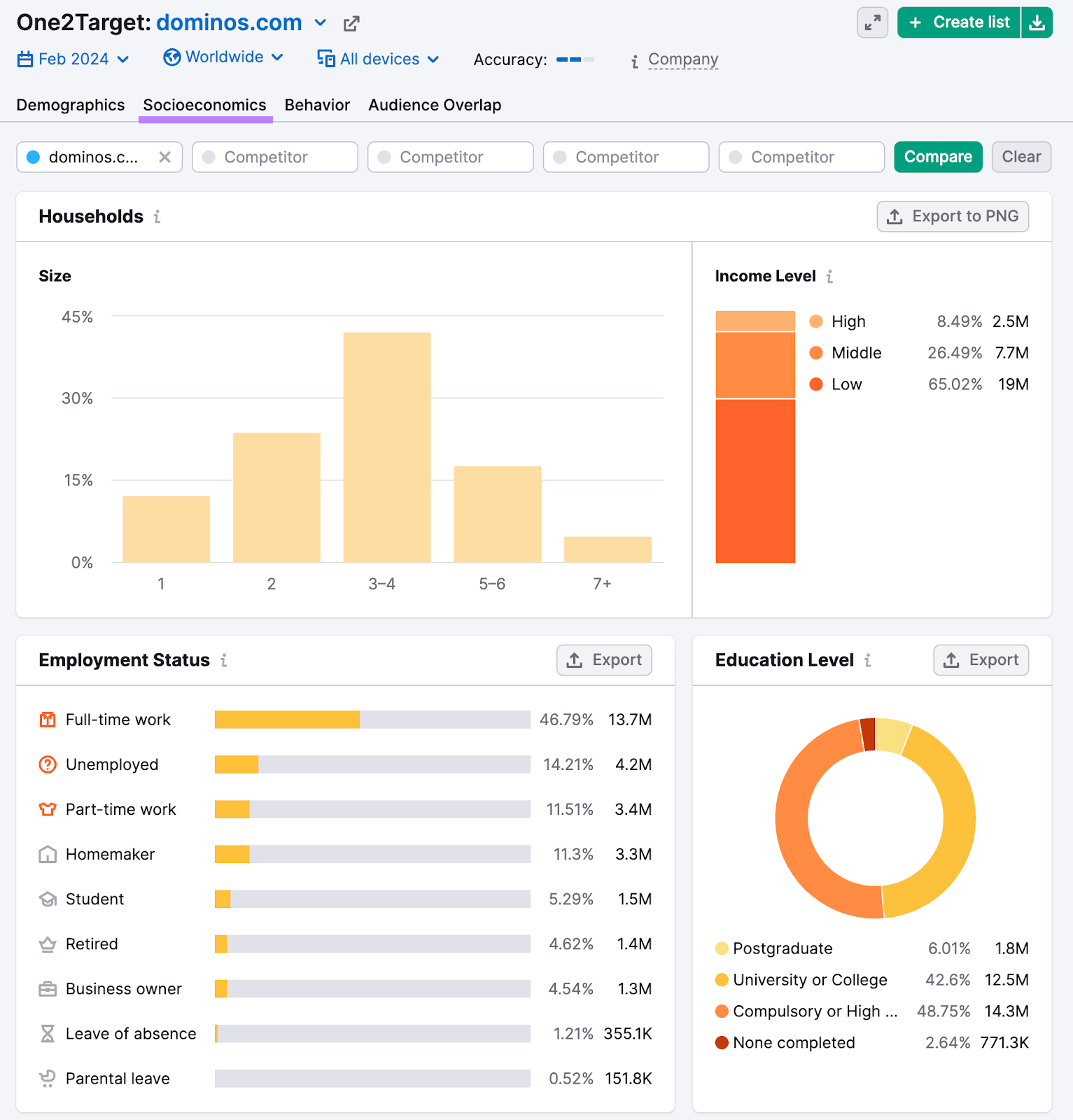
Now, click the “Behavior” tab to learn about the audience’s interests, device type usage, and most-used social media platforms.
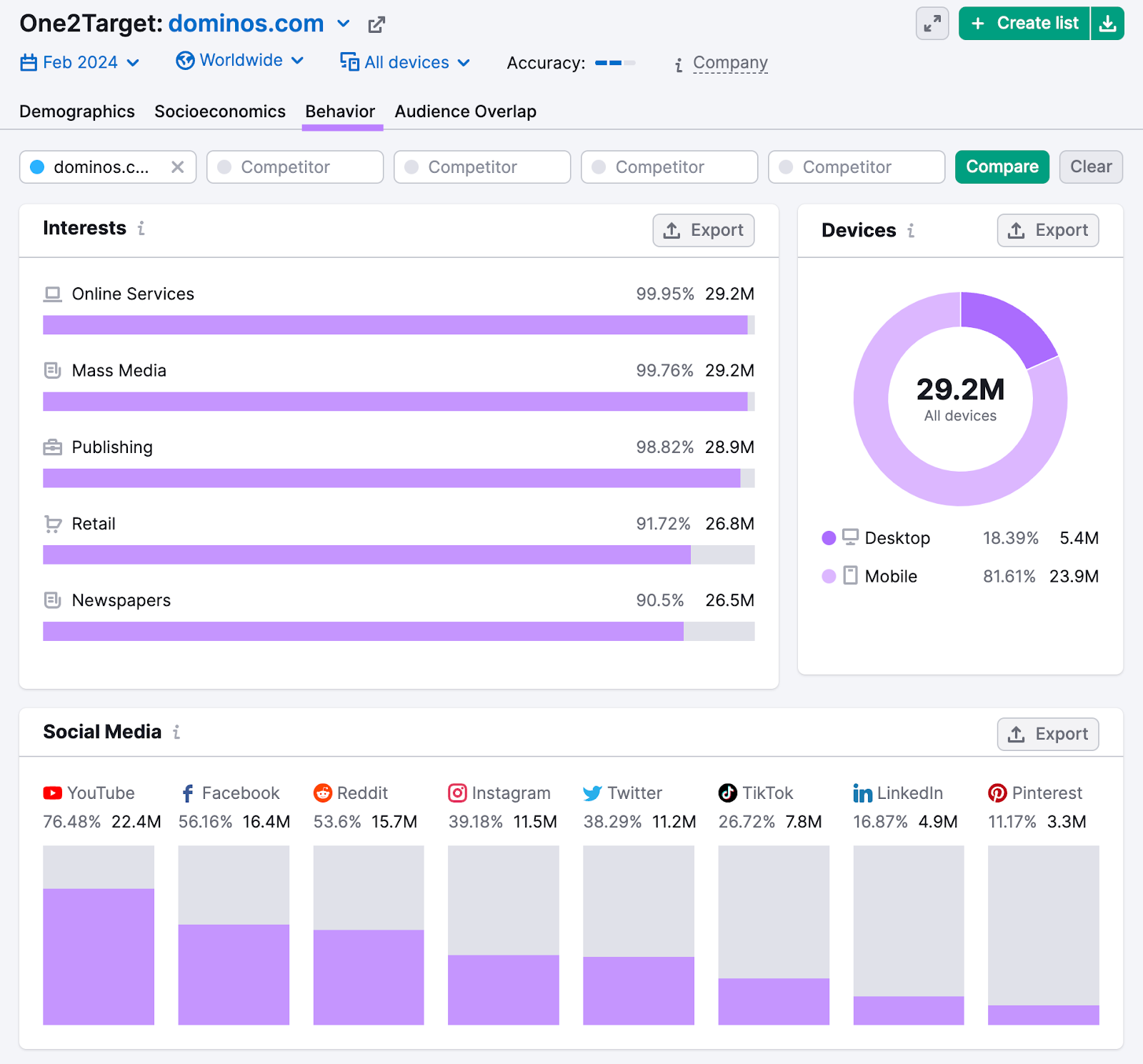
Looking at these insights, we can see that this audience:
- Is between 25 and 44 years of age, with a higher percentage identifying as male
- Is located in the U.S.
- Lives in a household of three to four people
- Is working full-time with a lower income
- Prefers to use mobile devices
- Predominantly uses YouTube, Facebook, Reddit, and Instagram
Use this information to inform your messaging. And determine the best social media platforms to focus on.
3. Find Industry Benchmarks
The next step is to identify industry benchmarks to see how you compare and gauge whether there’s room for improvement in your social media strategy. And help you set realistic goals.
First, return to Market Explorer. And click on the “Benchmarking” tab.
Next, click the “Organic Social” tab to see how much website traffic competitors drive from their social media marketing efforts.
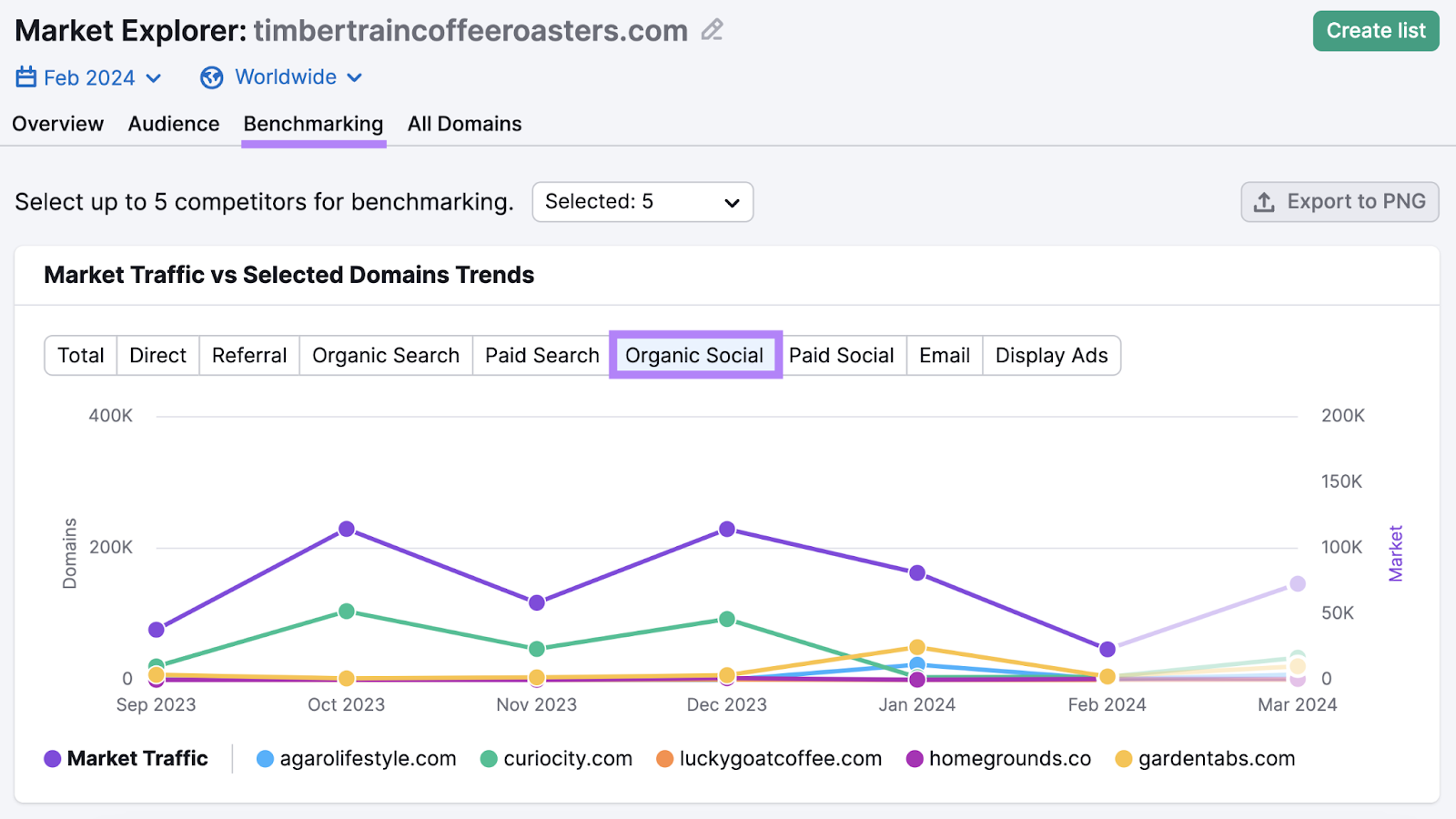
Note the amount of organic social traffic each of your five main competitors gets. And also consider the average.
Then, compare those numbers to your own. You can find the exact amount of traffic you get from social media traffic in Google Analytics.
Next, analyze your competitors’ engagement (likes, shares, etc.) to understand whether their content is resonating with their audiences. And might be worth replicating for your target audience.
Use Semrush’s Social Tracker (part of Semrush Social) to see competitors' social media engagement rates.
First, add the companies you want to analyze.
Then, click “Start tracking companies.”
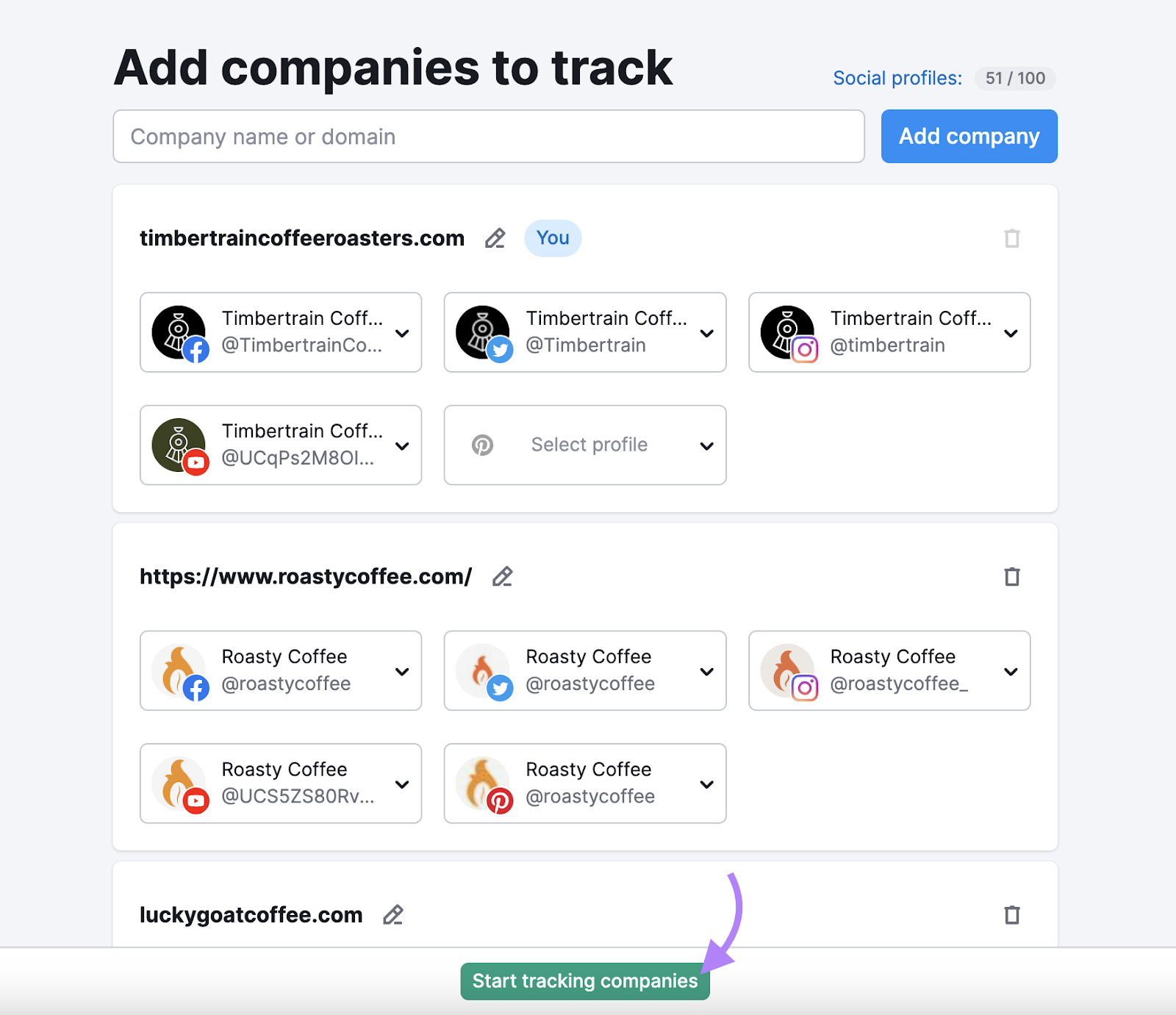
In the “Overview” tab, choose a platform you want to evaluate.
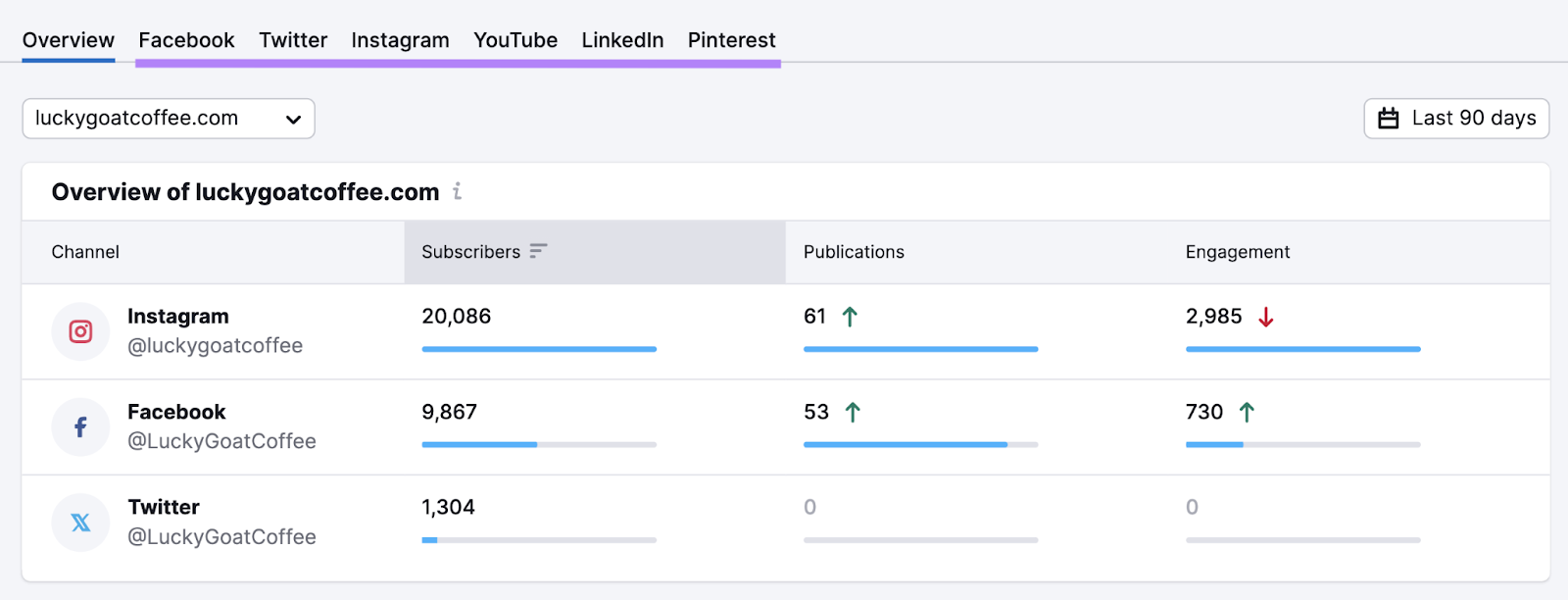
Then, click the “Engagement” tab to view specific engagement metrics like reactions, comments, and shares.
In this case, you can also see top reactions. Which helps you understand audience sentiment.
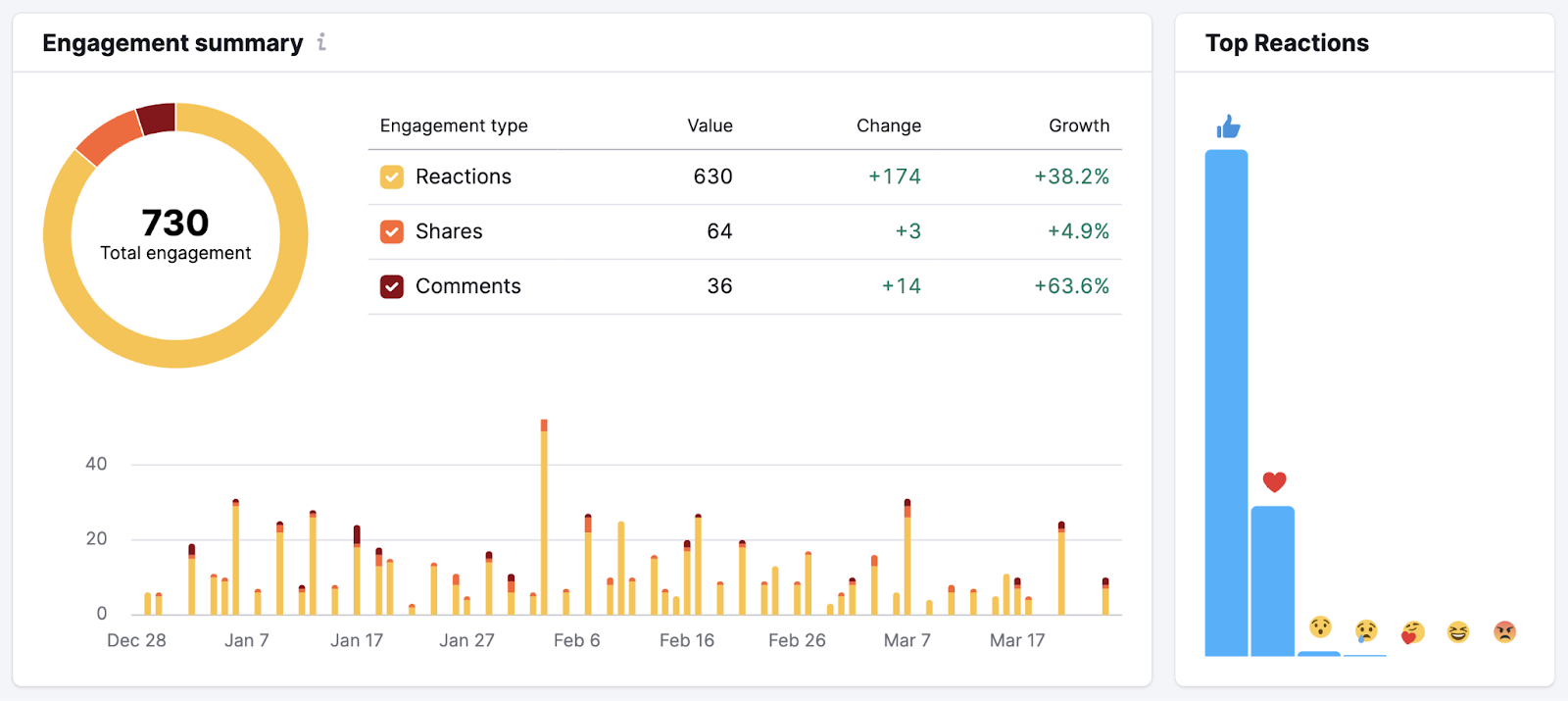
The tool makes it easy to compare your own metrics to your competitors’ metrics all in one place.
Finally, use a social listening tool to uncover conversations about your brand and your competitors. And see how sentiment across brands compares.
Use the Media Monitoring app for this.
All you have to do is quickly set up tracking for your company as well as your competitors.
First, go to the “Mentions” tab to see exactly what people are saying about each brand. And pay particularly close attention to those that come from social media.
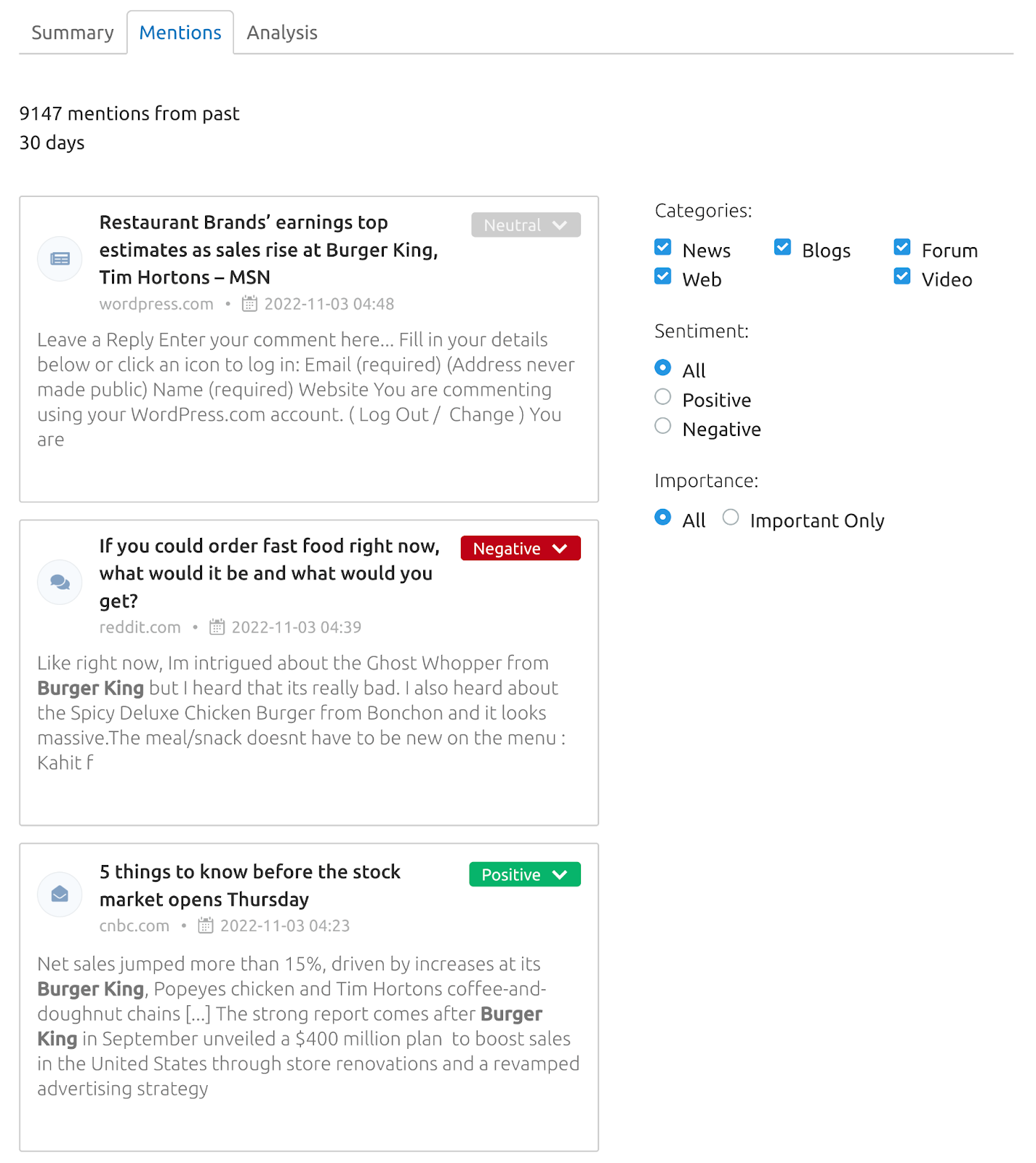
Then, go to the “Analysis” tab for every brand you’re targeting to get a sense of how sentiment differs for each.
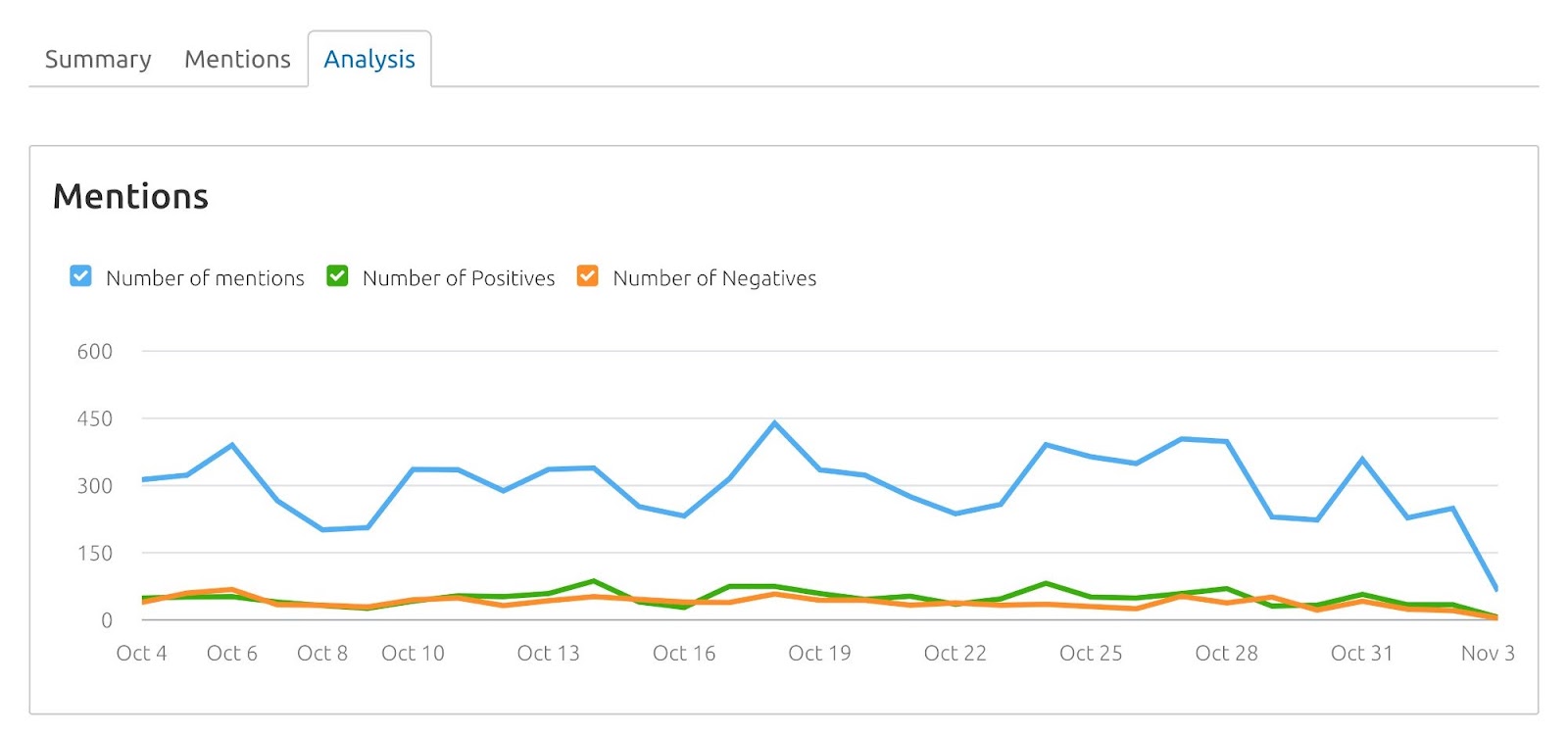
4. Analyze Your Competitors’ Content and Activity
Analyze the different types of social media content your competitors share as well as when they post it.
To gain insight into what works and what doesn’t.
Consider whether their posts are informational, aspirational, entertaining, or promotional. And find out which of these categories drives the most engagement.
Also, look for how competitors use content across different channels.
For example, do they post the same story on TikTok, Snapchat, and Instagram? Or, do they differentiate between channels? And what impact does this have on their social media performance?
Use Semrush Social’s Social Tracker tool to find out.
For example, click “Facebook” to see the selected competitors' top-performing posts over a specific time period.
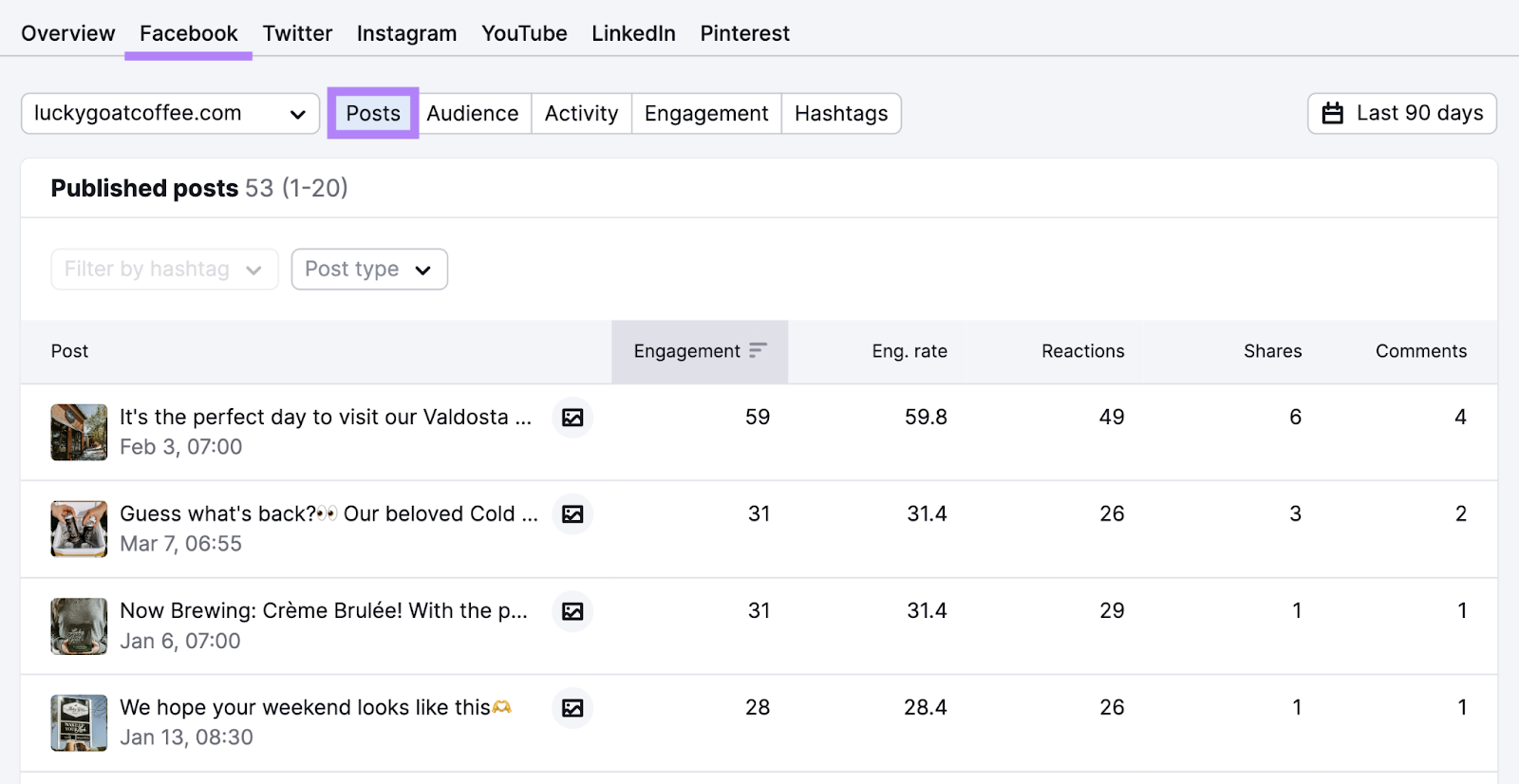
Note what these posts have in common. For example:
- What format are they?
- What topic do they speak about?
- What copy have they used?
- Do they include a call to action (CTA)? Where does it direct the audience to?
- What hashtags do they use?
You can also explore how competitors use images and video on social media.
Do they use product or lifestyle visuals? And which of these do people comment on the most?
Here’s an example of a product shot from Lucky Goat Coffee that shows how their product is made:
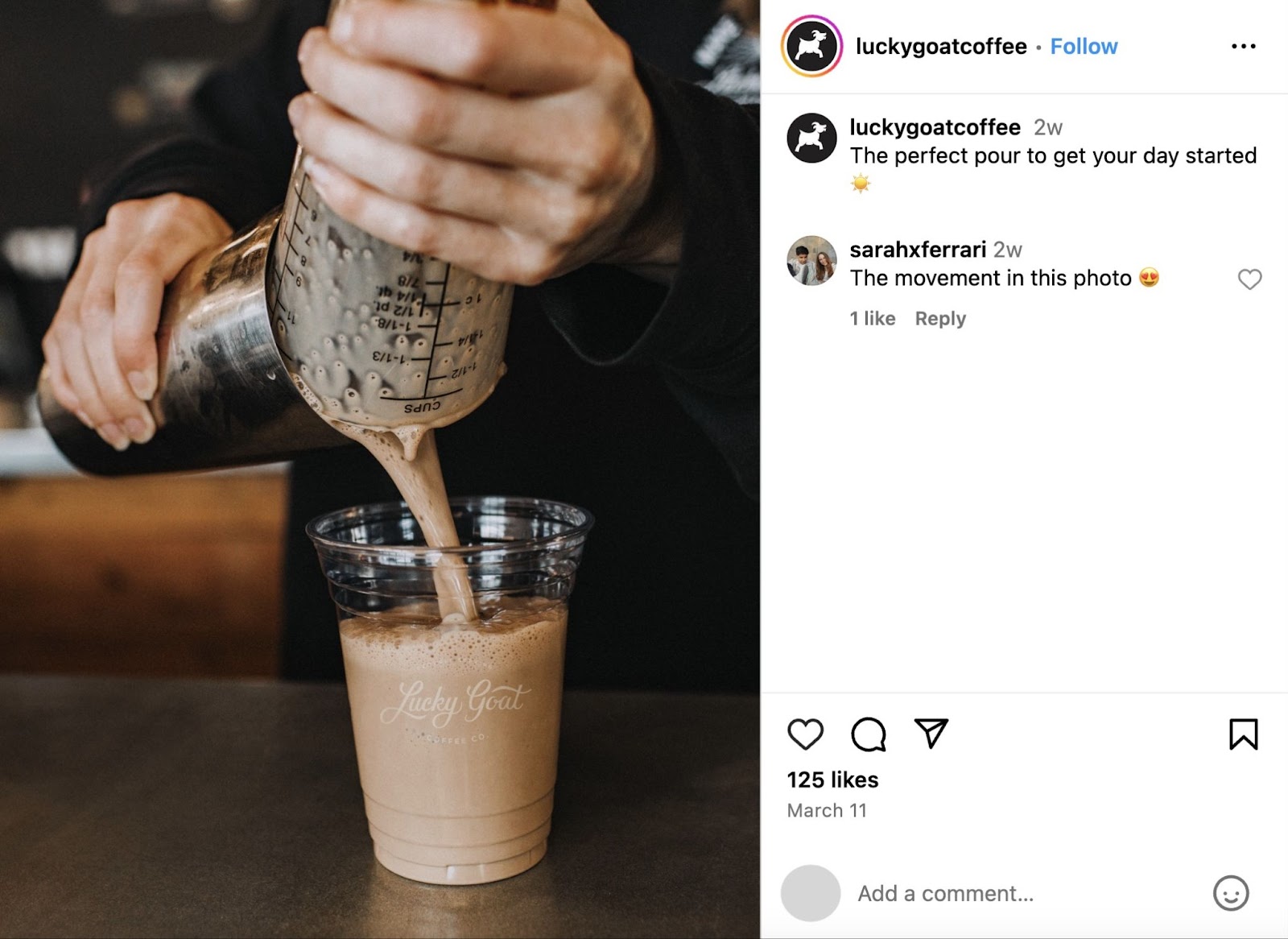
While there aren’t many comments, you can see that it’s received well over 100 likes. Which indicates it resonated with their audience.
And it’s a good idea to look into how often competitors share content. So you can optimize your own posting schedule for better performance.
Use Social Tracker to see your competition’s posting frequency and the days of the week people engage with their content.
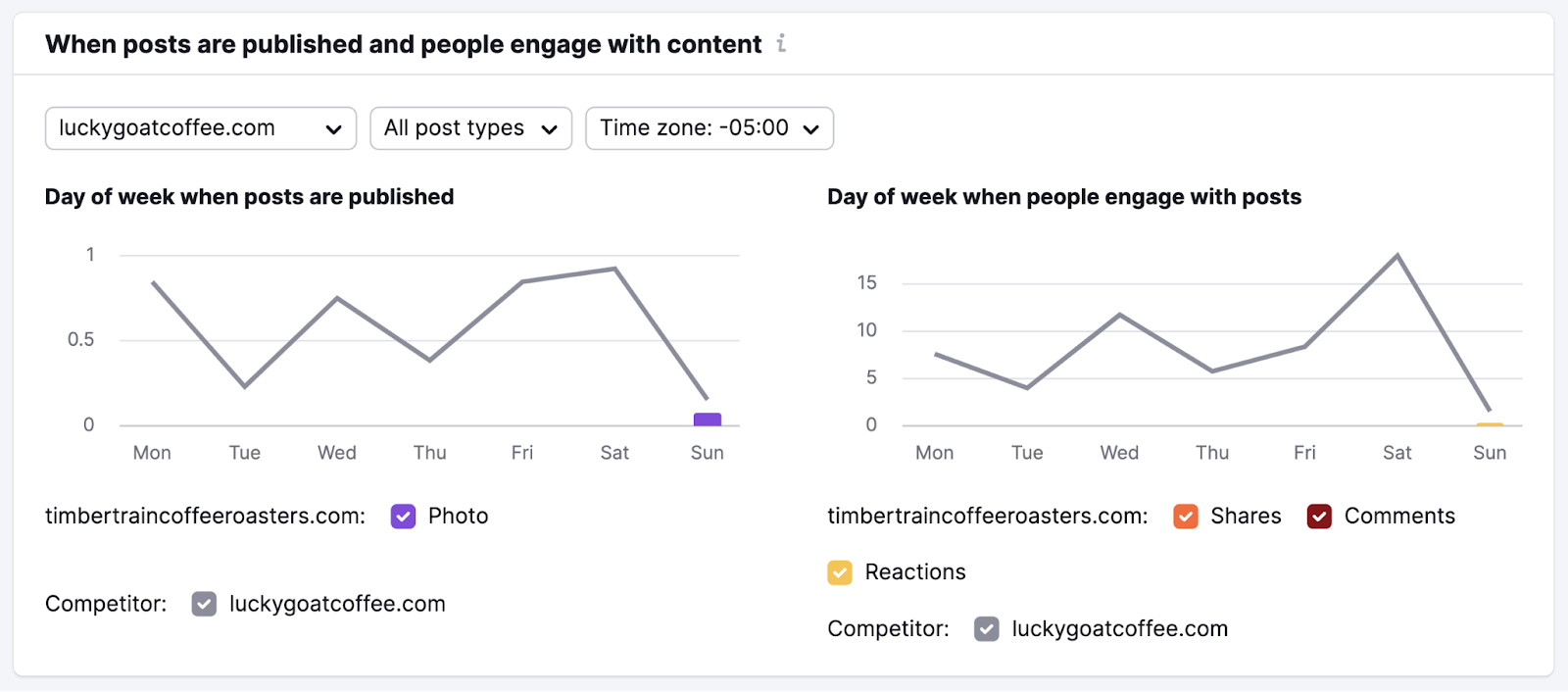
For example, if you notice a competitor posts consistently throughout the week and consistently generates high engagement, this signals the audience is receptive to regular updates.
Use the insights you gain from studying your rivals’ content and posting cadences to refine your own social media strategy.
5. Do a SWOT Analysis
Summarize your competitive analysis by conducting a strengths, weaknesses, opportunities, and threats (SWOT) analysis.
Here’s how to fill in each quadrant:
Strengths
Identify the areas where you meet or exceed industry benchmarks. Or demonstrate a unique and compelling point of view.
For example, let’s say you have high impressions and reach due to the use of compelling video content, interactive social media challenges, and user-generated content (UGC).
Weaknesses
Look at your weak points.
Maybe you notice your follower growth has stagnated over the past few months. Or, perhaps you struggle to generate authentic engagement on Instagram.
Opportunities
Explore opportunities to outperform your competitors.
Let’s say the competition creates localized content and targets a small segment of your target audience.
This could lead you to explore the possibility of expansion and tailoring social campaigns to wider regions. Which could increase your market share.
Threats
Assess the threats you face.
Like if a competitor regularly promotes deals and savings via social media to undercut your prices. Or, perhaps they spend heavily on social media advertising, but you don’t have the same budget.
6. Refine Your Social Media Strategy
Use insights from your analysis to adjust your social strategy. So you can work to improve your performance.
Now that you’ve studied what your competitors are doing successfully, you could incorporate similar tactics into your social media strategy. And see whether they drive similar results.
Like using platforms you don’t have a presence on but that resonate with your target audience. As long as you have the time and budget for it.
You can also use your analysis to uncover content gaps that neither you nor your competitors currently address.
Whatever your findings are, use them to inform your future social media efforts.
5 Social Media Competitor Analysis Tools
Semrush Social
The Semrush Social app is a one-stop shop for running a social media competitive analysis.
You can track up to 20 competitors and gather insights into their engagement rates, follower and subscriber counts, publication frequency, post types, and more.
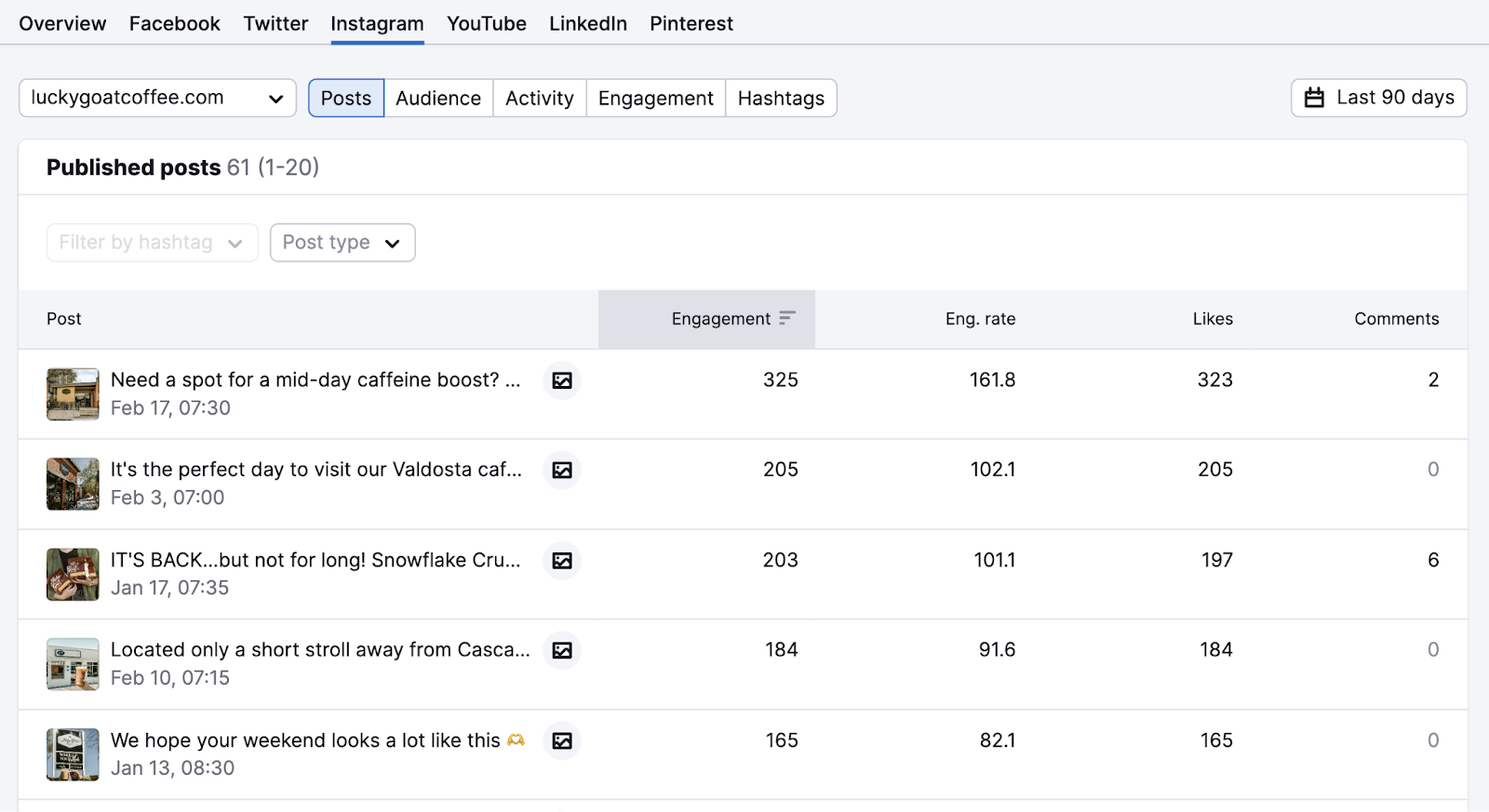
The app makes it easy to measure your own performance. And includes a publishing feature to ensure your campaigns always stay on track.
Pair it with Market Explorer to get an even bigger competitive advantage.
Agorapulse
Agorapulse helps you schedule posts, engage with your audience, and analyze social media metrics.
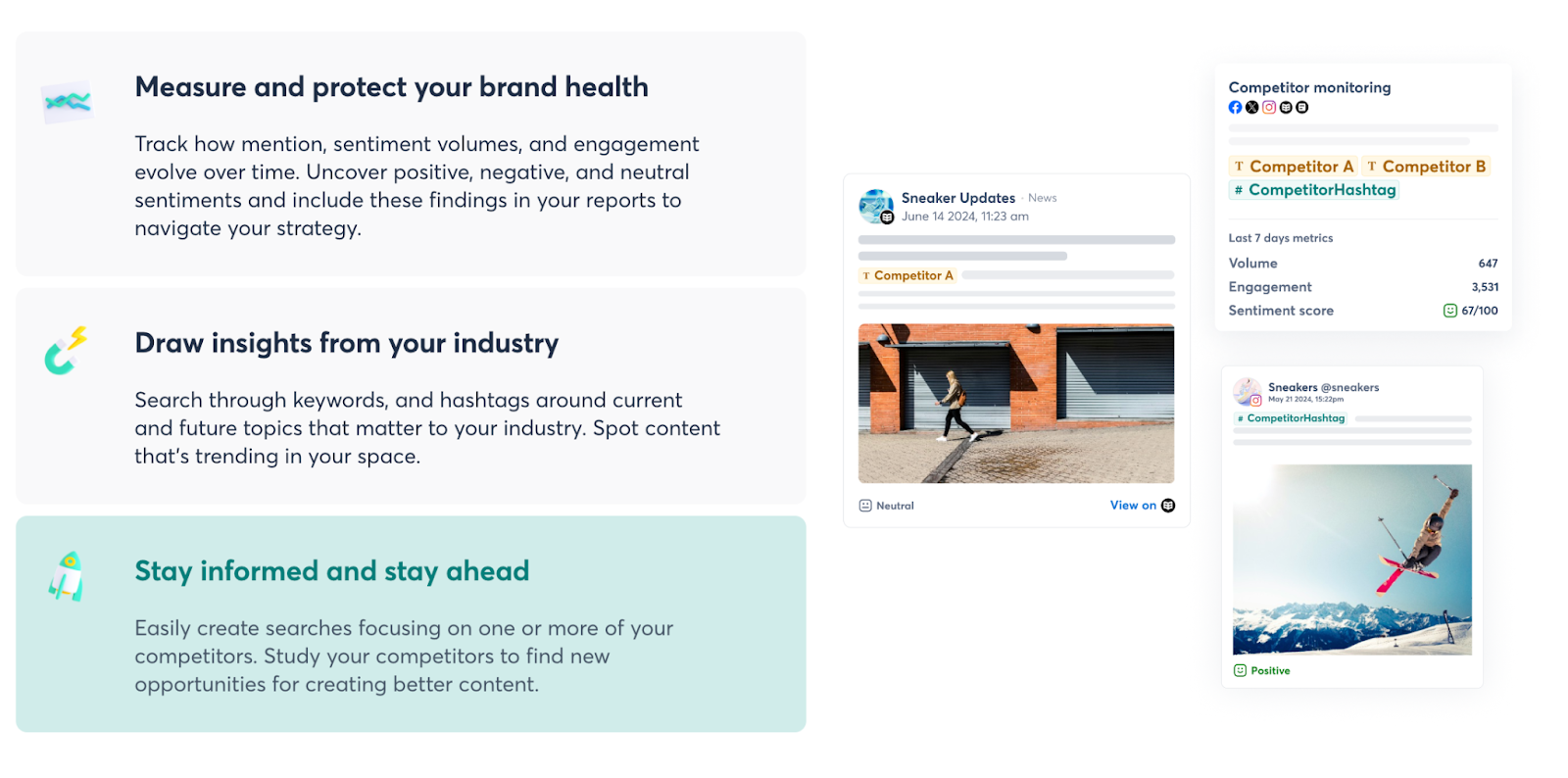
Image Source: Agorapulse
The tool includes competitor activity tracking, brand mention monitoring, and audience engagement analysis.
It also allows you to compare your performance against competitors and track key metrics over time.
Quintly
quintly enables you to track your social media performance and compare your social media metrics with those of your competitors.
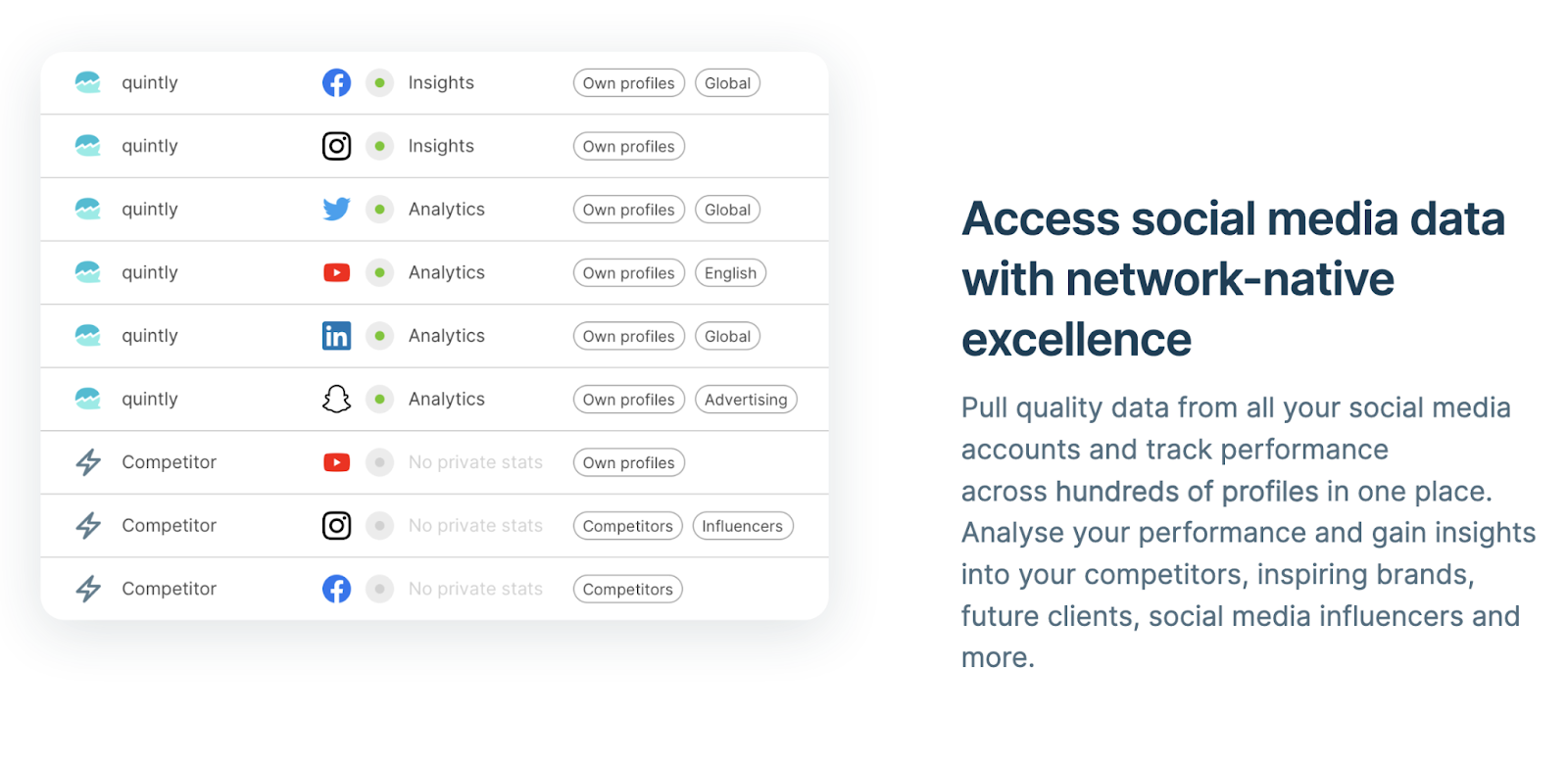
Image Source: quintly
Vaizle
Vaizle offers competitive benchmarking features, allowing you to compare your social media performance with your competitors.
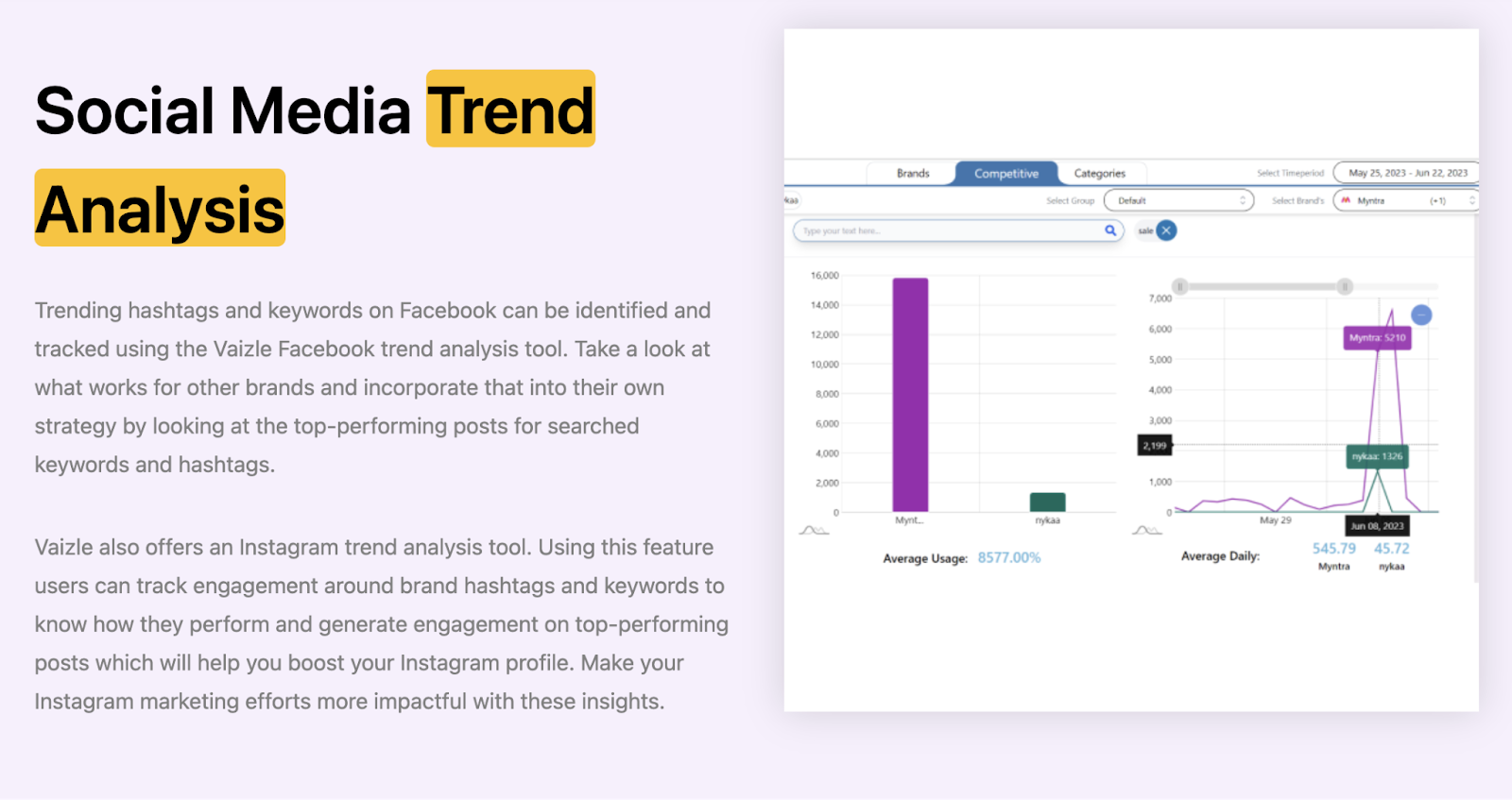
Image Source: Vaizle
It provides trend analyses and performance metrics to help you identify opportunities for growth.
Iconosquare
Iconosquare is a social media analytics and management platform primarily focused on Instagram and Facebook.
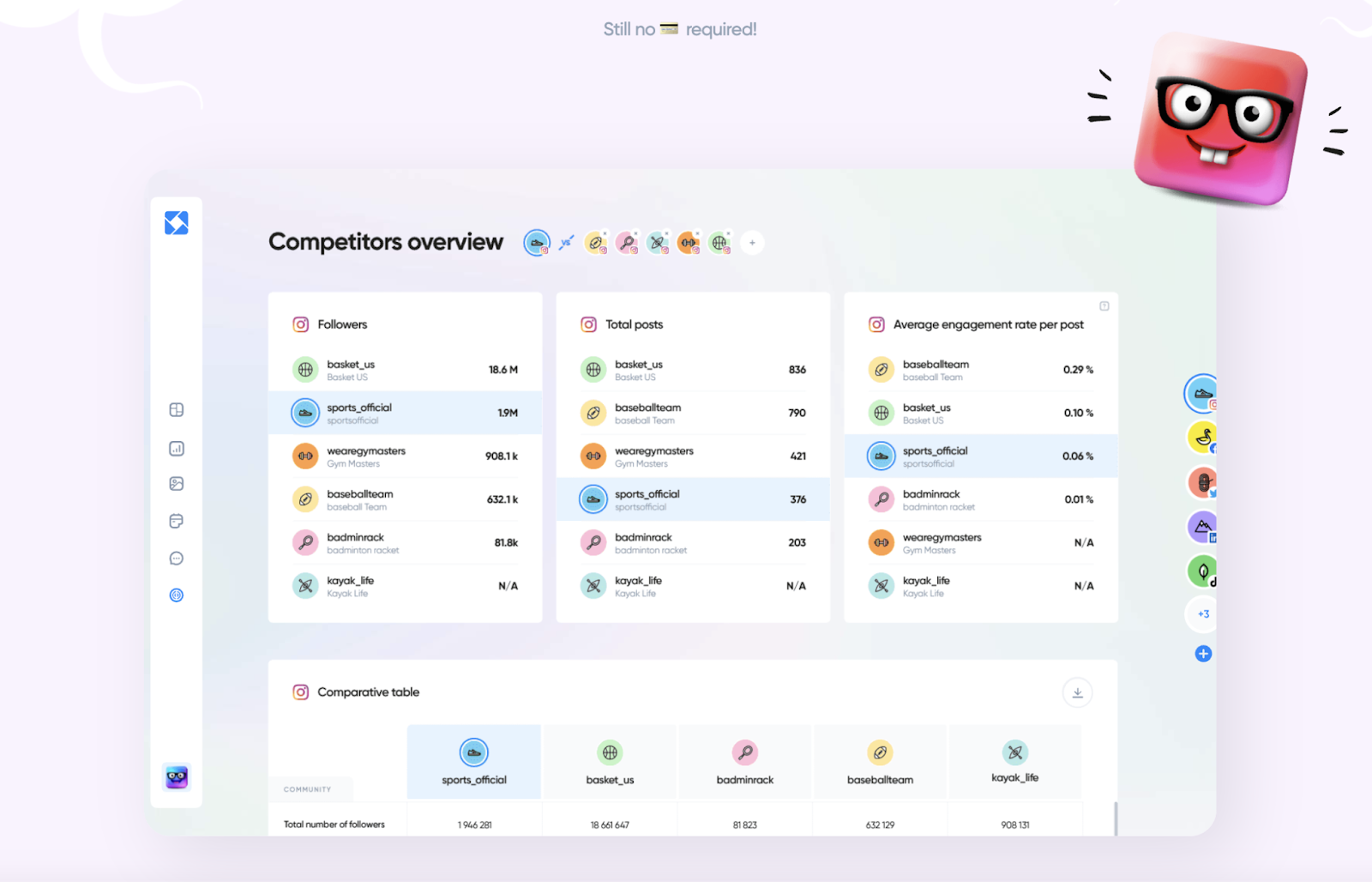
Image Source: Capterra
Iconosquare offers features for tracking competitor activity, analyzing audience engagement, and monitoring social media metrics.
Get Data-Driven Insights on Your Competition
Knowing how to do a social media competitor analysis report is essential for social media professionals at all levels.
It can help you better understand your competitors' strategies, strengths, and weaknesses in the social media landscape. And identify opportunities to improve your own approach.
Leverage Semrush’s suite of tools to streamline your analysis.
